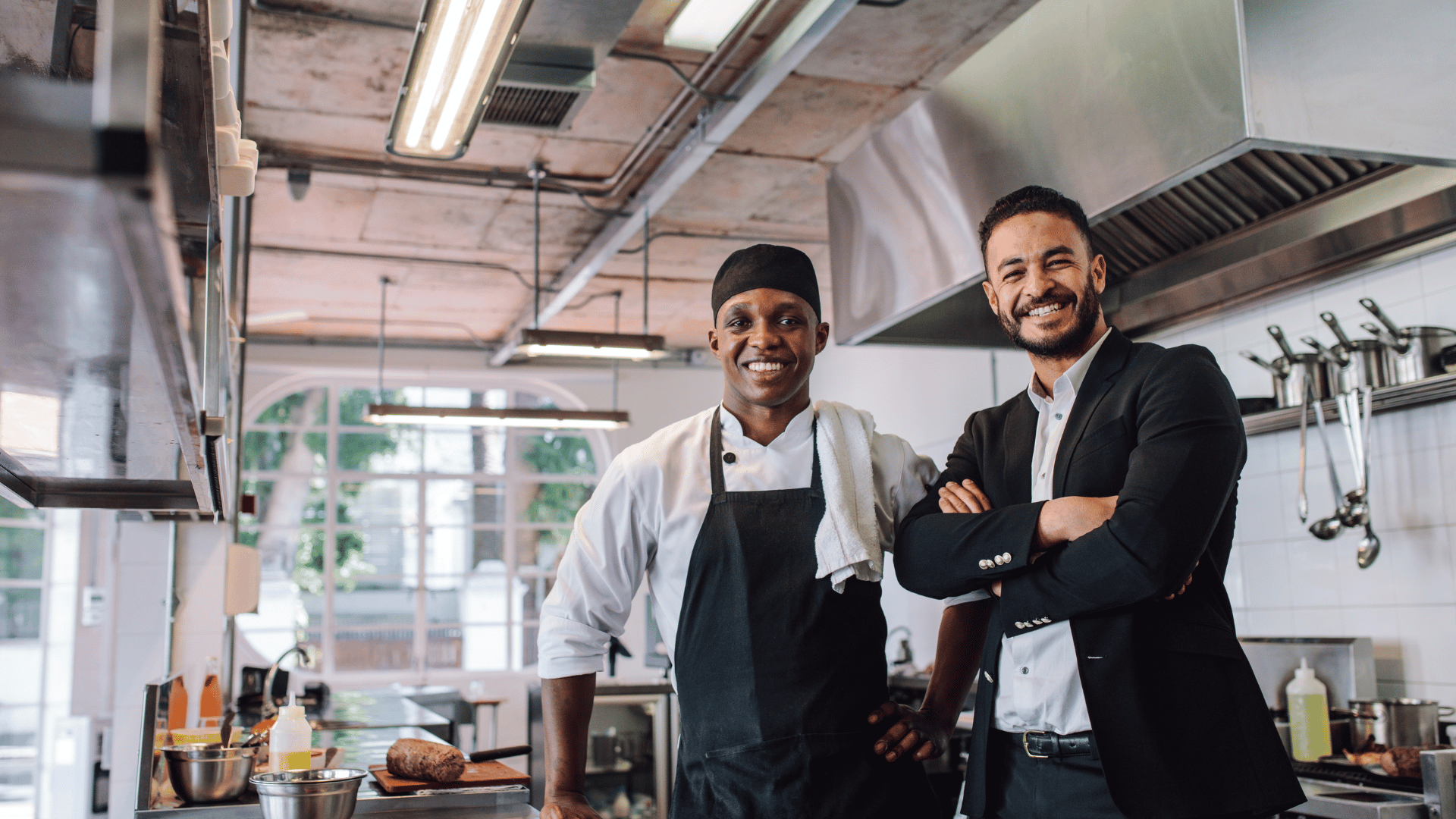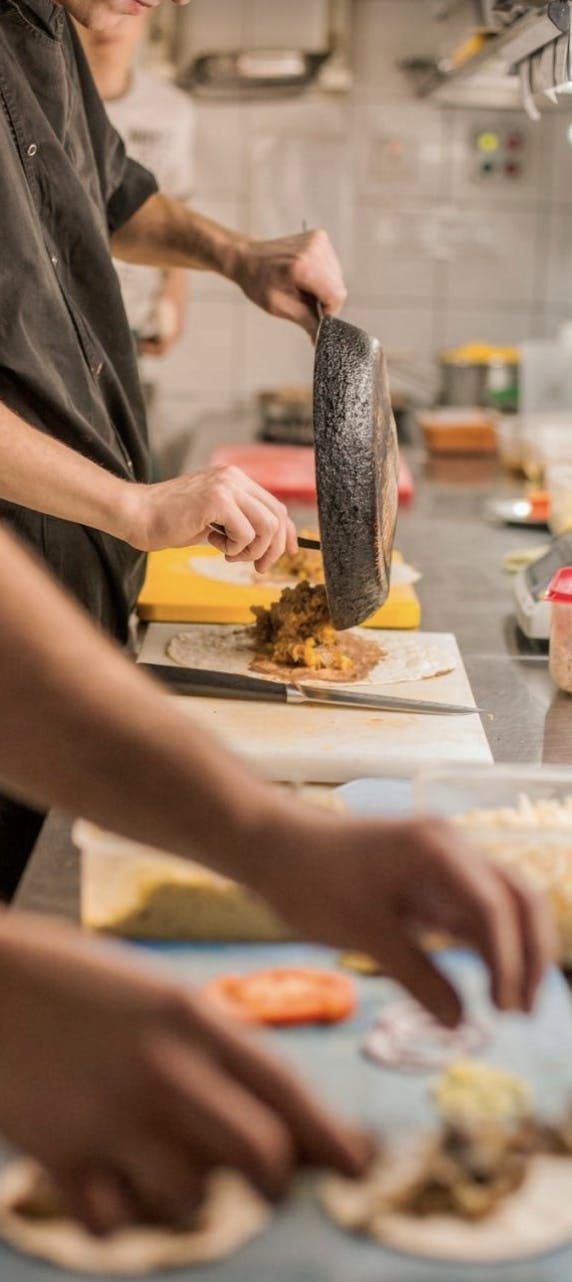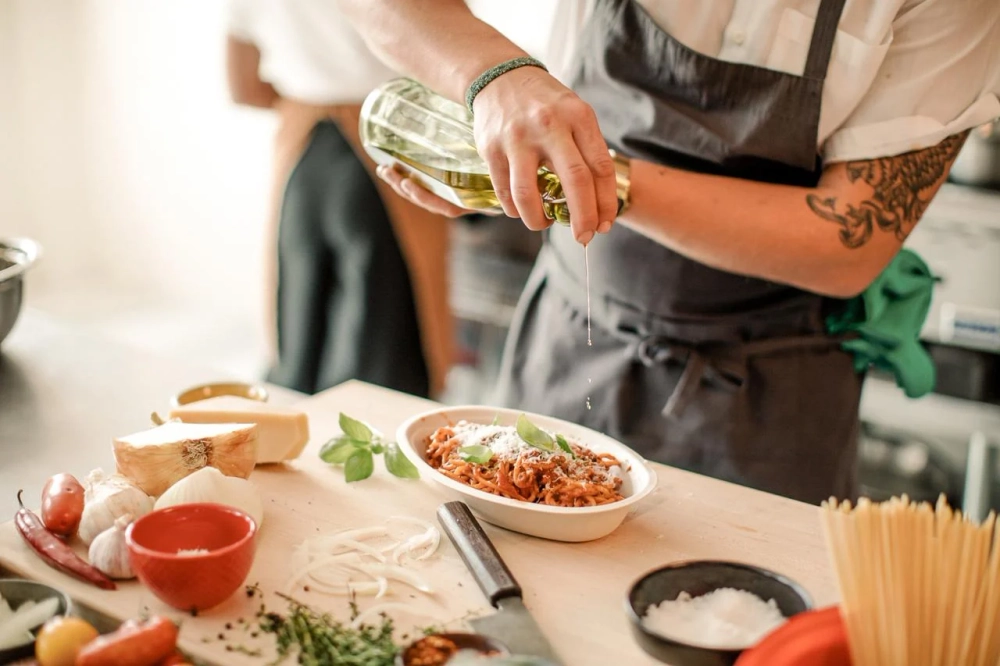How to Franchise a Restaurant: A Step-by-Step Guide
Table of Contents
CloudKitchens
How many tacos can be delivered from a 1000sqft restaurant?
The same amount as a 200sqft ghost kitchen.

If you’re looking to learn how to franchise a restaurant, congratulations are in order—your business is ready to grow.
While it’s only one of many ways to grow, franchising your restaurant can help you reach new customers, gain brand recognition in a new region, develop merger or acquisition opportunities, and so much more.
If you think your restaurant is a good candidate for franchising—what’s next? In this guide, we’re breaking down how to open a franchise restaurant. To clarify, we’re teaching existing restaurant owners how to start a franchise operation—how to start a franchise restaurant as the parent company.
Explore the franchising process step-by-step below.
What are restaurant franchises?
Restaurants can expand in various ways, but three of the most common growth tactics are:
- Self-funded growth (re-investing business proceeds into growth measures)
- Investor-supported expansion (growing a restaurant with outside funding)
- Franchising
The latter will be our focus in this guide. Simply put, franchising allows business owners to lean on a parent company’s resources, knowledge, and expertise as they grow a “branch” of that parent company. Meanwhile, the parent company (that’s you) gets to expand its brand, access startup capital from franchisees, and more.
You’ve probably heard of some of the biggest names in restaurant franchising (even if you can’t find one of these franchises near you):
- McDonald’s
- Domino’s Pizza
- Outback Steakhouse (and other Bloomin’ Brands outfits)
- Olive Garden (a subsidiary of Darden Restaurants Inc.)
If these international household names are any indication, franchising has the potential to become a highly successful model for your growing restaurant business.
Pros and Cons of Restaurant Franchising
| Pros | Cons |
|---|---|
| Leverage on existing brand awareness | High startup costs and fees/royalties |
| Ready-to-eat/order customer base | Not able to innovate the menu much |
| Product-market fit and returns | Poor financial privacy |
Pros of Starting a Restaurant Franchising
1. Brand Awareness
Creating a new brand or business is both expensive and demanding. It requires substantial funds, tools, and a dedicated team. By harnessing the established brand of the franchisor, developed over the years, you can reduce the initial cash investment burden and concentrate on delivering excellent cuisine.
2. Customer Base
Similar to brand awareness, the franchisor has cultivated popularity and demand over the years, making it the go-to choice for specific types of food such as pizzas, burgers, and tacos. Therefore, you don’t need to worry about lacking demand or spending money to acquire customers.
3. Product Market Fit & Returns
The franchisor has iterated multiple times, demonstrating a proven product-market fit (PMF). The ability to build a strong brand and sustain market presence over an extended period indicates customer satisfaction with their food. As a franchisee, this implies better returns from the outset.
Cons of Starting a Restaurant Franchising
1. High Costs
Starting a franchise restaurant isn’t feasible for everyone. The costs vary based on the chosen franchisor, ranging from $20,000 to $100,000 or more. In addition to these initial fees, there are additional expenses like real estate, equipment, staffing, marketing, and more. Learn more about the associated costs of starting a franchise here.
2. Limited Innovation
The franchise contract, aimed at protecting the parent brand and its products, imposes limitations on the franchisee’s ability to easily modify the menu or introduce new products. While some localization might be permitted upon approval, this hinders franchisees from making swift iterations to address local customer needs.
3. Poor Financial Privacy
Many franchise agreements include a provision allowing the franchisor to have full oversight of the franchise’s financial aspects. If you’re uncomfortable with others closely monitoring your financial matters, franchising might not be the ideal business venture for you.
How to franchise a restaurant: a step-by-step guide
What does it take to become the next big-name franchise? Let’s explore how to franchise a restaurant in ten steps.
1. Figuring out if your restaurant franchise is feasible
Why doesn’t every popular neighborhood restaurant try to become a national (or even just regional) franchise? Because it isn’t a feasible growth model for every restaurant.
Before you take any other steps, consider how you’ll address some of the most common setbacks restaurateurs face when trying to franchise:
- Scale Issue: Imagine that you start another restaurant that’s identical to yours in every way: same menu, suppliers, building, and prices. You’ll essentially double your workload once you start the second. Even if you bring in a franchisee (who will have some capital and a few big ideas), you’re still at the helm of not one, but two restaurants.
- Liquidity: While you might have an emergency fund tucked away for potential catastrophes at your restaurant (like major equipment breakdowns or ingredient price fluctuations), is that fund big enough to cover the costs of opening a new restaurant and maintain financial peace of mind (for you and your franchisee)? You simply might not have enough cash in the bank yet.
- Demand: Is there enough demand to sustain your restaurant in your new market (or your existing market if you want to start franchising locally)? If market research doesn’t indicate potential success, keep marketing your current restaurant before you start franchising.
2. Develop your restaurant franchise business plan
While writing a restaurant business plan deserves its own guide, your business plan should (at minimum) include:
- Your business goals
- A current financial analysis
- Short- and long-term financial forecasting
- Your brand’s mission, vision, and values
A fully-formed business plan can help you navigate the early years of franchising in two major ways:
- It’ll show franchisees (whom you’ll be courting in your franchise infancy; more on this below) that you have a sound plan for making your joint venture work.
- It can serve as a foundational document as you reach critical turning points in your franchise business. When you’re considering changing a beloved menu item or revisiting a relationship with a long-term supplier, for instance, you can return to your original plan to help make an informed, intentional decision.
3. Securing financing for your restaurant franchise
While we discussed investor-supported growth as a distinct growth method above, it’s also one of a few ways you can secure funding for your franchise operation, along with:
- Leveraging your own capital
- Applying for a traditional business loan through a bank or credit union
- Collecting a “franchise fee” from your first franchisee
The last method is one of the most common, and it can be a hard sell for potential franchisees in the early days. But you can leverage the worth of your existing assets (and access to them) to convince franchisees to pay the entry fee.
4. Establishing a legal structure
Legal experts recommend that restaurateurs establish a franchising company as a separate legal entity from their primary restaurant company. Eventually, when the paperwork is done and you’ve officially started a joint venture with a franchisee, you should have three distinct companies with their own sets of books:
- Acme Franchising, LLC (the parent company for every future franchise location)
- Acme Eats, Inc. (your original restaurant)
- Acme Eats Springfield, Inc. (your first franchise location)
Ensuring that all three of these companies are separate legal and financial entities should protect each individual business (including your original restaurant) if one of them experiences legal or financial trouble.
5. Creating a franchise operations manual
Consistency is key for franchise businesses. A franchise operations manual will help each franchise location consistently embody the parent brand by:
- Preparing menu items the same way at all locations
- Adhering to a brand-wide dress code or uniform
- Decorating facilities or designing facilities to match company colors and standards
- Streamlining processes like HR, payroll, recruitment, and vendor negotiation
The last method is one of the most common, and it can be a hard sell for potential franchisees in the early days. But you can leverage the worth of your existing assets (and access to them) to convince franchisees to pay the entry fee.
Your franchise operations manual should be as detailed as possible, but be open to modifications—as your franchise restaurant grows, so will your manual. Whenever you make changes, ensure that every franchisee has the latest version of the document.
6. Creating a franchise operations manual
Consistency is key for franchise businesses. A franchise operations manual will help each franchise location consistently embody the parent brand by:
- Preparing menu items the same way at all locations
- Adhering to a brand-wide dress code or uniform
- Decorating facilities or designing facilities to match company colors and standards
- Streamlining processes like HR, payroll, recruitment, and vendor negotiation
The last method is one of the most common, and it can be a hard sell for potential franchisees in the early days. But you can leverage the worth of your existing assets (and access to them) to convince franchisees to pay the entry fee.
Your franchise operations manual should be as detailed as possible, but be open to modifications—as your franchise restaurant grows, so will your manual. Whenever you make changes, ensure that every franchisee has the latest version of the document.
7. Finding franchisees
If your franchise becomes successful enough, you’ll likely be approached by aspiring franchisees. But as we mentioned above, this is unlikely to be the case in the early days of your franchise restaurant. You’ll probably have to recruit your first few partners yourself.
Be as selective as possible when choosing your first franchisees. These first partners will set the tone for your growing brand and collaborate to solve early brand-wide problems.
Look for candidates with
- Significant restaurant experience—preferably in all food service roles, but specifically in management
- Enough capital to pay the franchise fee and startup costs
- A verifiable history of ethical and successful business practices
Early franchisees will be some of the first faces of your growing brand—choose them wisely.
8. Marketing and launching your restaurant franchise
As you’re tackling all of the other steps in this list, don’t forget about the most important part of opening a franchise restaurant: telling customers about it.
You might be too busy to tackle marketing on your own, so don’t be afraid to hire an internal employee or an outside marketing firm to take the reins. Delegating tasks you’re not an expert in (like managing social media) will free up your time for tasks that require your expertise like menu planning and vendor negotiations.
Once your marketing is up to snuff, prepare to launch your first franchise location: an event that should include all of the fanfare it so deserves.
9. Managing and supporting your restaurant franchise network
As you continue recruiting franchisees (and as ambitious candidates start approaching you), one of your most important roles as the franchise business owner is to support your network of franchisees.
This role deserves a guide of its own, too. But some of your responsibilities in this capacity include:
- Maintaining brand integrity at every location (I.e., making sure menus and methods are consistent across locations)
- Helping franchisees overcome operational challenges
- Administering (and maintaining) a franchisee training program
- Overseeing the finances at every location
This is just the tip of the iceberg. As your business grows, consider hiring more franchise management staff to help shoulder the burden of leadership.
10. Measuring the success of your restaurant franchise
How do you know if your restaurant franchise is successful? You should measure your performance by evaluating:
The success of individual franchises – How is each restaurant location doing? Are they turning a profit, satisfying customers, and embodying your mission? Use a combination of quantitative and qualitative metrics to assess a branch’s success.
The success of the brand as a whole – Is the parent company making (and saving) money? Is your brand image generally positive in the market? Do people want to work at your franchise locations? These are just a few elements you can assess to determine how well your parent company is doing.
11. Planning for the future
Business owners in all sectors must be future-minded. One way to make plans for the future, maintain a goal-oriented approach, and make decisions that secure your franchise restaurant’s future is to return to your business model.
Remember those short- and long-term financial forecasts you made in your original business plan? As your business grows, make a habit of refreshing those forecasts regularly to maintain a constant eye on the horizon.
Note that you can plan for more than your financial future. You can also set goals (and make plans to meet them) related to:
- Your brand’s image and reputation
- Your menu offerings
- Your ingredient sourcing
- Your human resources efforts
Staying focused on the future of your brand will help you make savvy business decisions in the present.
CloudKitchens: Reimagining restaurants of the future
Learning how to open a franchise restaurant can be overwhelming—the learning curve is high, you need substantial start-up capital, and there are many challenges to overcome as you rise to the top.
Future-minded franchise restaurateurs always keep their eyes open for innovative opportunities to expand their brands. As the demand increases for quality food delivery, for instance, how will you answer the call?
When you’re ready to embrace the future of delivery, partner with CloudKitchens. We help restaurant owners by providing seamless delivery, cost savings, and ghost kitchen spaces.
Instead of navigating the muddy waters of the startup phase for months on end, CloudKitchens partners can have their delivery businesses up and running in just weeks. Now offering ghost kitchens in Austin, NYC, Orlando, Chicago, Los Angeles, and many more cities across the U.S.! Expand your restaurant business and take advantage of the bustling food delivery scene.
Learn more about how CloudKitchens is changing the game for restaurants—from small businesses to national franchises.
Read more:
- How To Structure a Franchise Business Plan: 9 Steps
- The Ultimate Guide to Franchise Marketing | CloudKitchens
- What are the real costs of operating a franchise? A complete breakdown
- How to measure the restaurant franchise success rate?
- Restaurant Franchise | CloudKitchens
Explore ghost kitchen locations across the US:
- Ghost kitchens in San Francisco
- Ghost kitchens in LA
- Ghost kitchens in NYC
- Ghost Kitchens in Toronto
- Ghost Kitchens in Atlanta
- Ghost Kitchens in Dallas
- Ghost Kitchens in Chicago
- Ghost Kitchens in Denver
- Ghost Kitchens in Miami
| DISCLAIMER: This information is provided for general informational purposes only and the content does not constitute an endorsement. CloudKitchens does not warrant the accuracy or completeness of any information, text, images/graphics, links, or other content contained within the blog content. We recommend that you consult with financial, legal, and business professionals for advice specific to your situation. |
Sources:
Investopedia. What Is a Franchise, and How Does It Work? https://www.investopedia.com/terms/f/franchise.asp
Investopedia. 10 Biggest Restaurant Companies. https://www.investopedia.com/articles/markets/012516/worlds-top-10-restaurant-companies-mcdsbux.asp
NerdWallet. How to Write a Business Plan, Step by Step. https://www.nerdwallet.com/article/small-business/business-plan
US Small Business Administration. Franchise Fees: Why Do You Pay Them and How Much Are They? https://www.sba.gov/blog/franchise-fees-why-do-you-pay-them-how-much-are-they
More insights & stories
There’s more where that came from.
Get in the know and check out our additional insights





